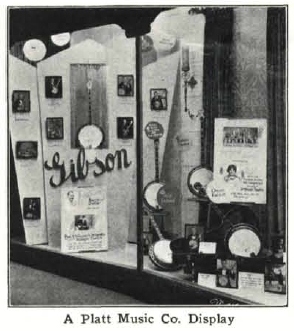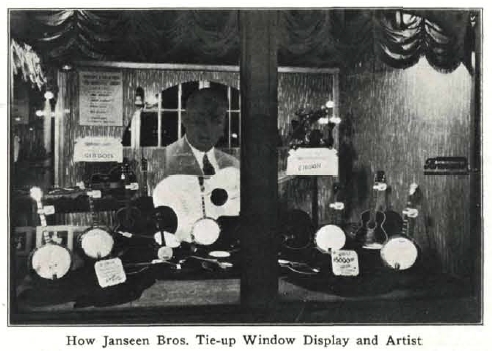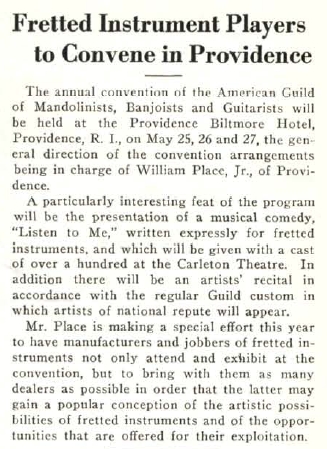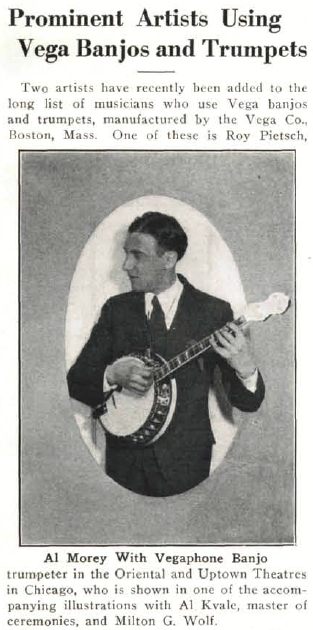| Music Trade Review |
|
Die Zeitschrift Music Trade Review ist online verfügbar: |
|
Music Trade Review - Music
Industry Magazine
Online Library: 1880 - 1933, 1940-1954 The Music Trade Review was published out of New York from 1878 until at least 1956. It apparently suspended publication with the January 1933 issue. Publication was resumed under different management sometime between 1937 and 1940. Our online library contains issues from 1880 to 1933, and from 1940 to 1954. Additional years are available for review at a number of libraries. Search www.worldcat.org for more information about the holdings of other libraries, or ask your local librarian for assistance. |
| |
| --
google Anzeige -- |
| Bitte
teilen sie diese Seite: |
|
|
Hunting the Fretted Instrument Prospectby B. B. WilsonTHE old saying, "There are larger fish in the sea than have ever been caught," might be paraphrased to read, "There are more fretted instrument prospects in the U. S. A. than have ever been dreamed of." This thought was suggested by a visit to the factory of Gibson, Inc., Kalamazoo, Mich., and an opportunity to study, at close range, the methods used by this organization to create and ripen an unusually large volume of annual fretted instrument sales. Fretted instruments, of course, are familiar to all members of the musical merchandising trade as the banjo, guitar, mandolin and ukulele. Since having the advantage of a "close-up" view of the fretted instrument industry as represented by the Gibson organization, we learn that there are many more members of this interesting family. For example, we listen to the entrancing strains of the mandola— an instrument corresponding to the viola of the violin family. To the baritone voice of the mando-cello, which is, of course, the cello, played a la plectrum or pick—and to the deep, pulsating rhythm notes of the mando-bass. As a variation there is the bewitching music produced by instruments known as the mandolin- banjo, the cello-banjo, the guitar-banjo and the bass-banjo. In fact, the fretted instrument family has revealed itself as lacking nothing to complete its possibilities as a full symphonic ensemble— something that may be, perhaps, a surprise to many musical merchandisers outside of active distributors of Gibson products. It is interesting to note that the Gibson Co., through its distributors, enjoys a profitable volume of sales of these lesser-known instruments, as well as the banjo, guitar, mandolin and ukulele. And—as the story writers would phrase it—"thereby hangs a tale." How does the Gibson company go about creating an active and profitable demand for these instruments? That was the leading question in my thoughts as I chatted with Guy Hart, general manager, and Frank Campbell, sales manager of Gibson, Inc., and in answer to a question I was permitted an intimate view of the effective system which has brought this organization to the front as one of the leaders in the musical merchandising industry. Perhaps it may seem odd to refer to a merchandising policy as a "system." Yet "system" is the right word, for Gibson progress has been based, first and last, upon the adopting of a carefully thought-out plan of action to which it has strictly adhered. First in importance, at least to many musical merchandisers, is the consistent program of national advertising. Followed year in and year out, using a moderate but effective space in a dozen or so of the leading national magazines, the number of live leads produced over an annual period is a revelation both to the power of the advertising dollar, properly expended, and to the active interest of the American public in tilings musical. This may appear to be a wasteful expenditure of money, but if someone does not keep the thought before the general public interest in fretted instruments will soon die out. These leads art- not only turned over to the local distributor in each community for personal contact and attention, but are also followed up direct with a strong mail campaign from the home office. A close inspection of this follow- up reveals that it is no ordinary mailing campaign, but a well-rounded affair in which the prospect is appealed to from every possible angle to induce action. Cold indeed would be the individual who does not respond actively to one or another of these appeals. By the time the last mailing has "gone home" to the prospect, both Gibson, Inc., and the local distributor have sufficient data to definitely "catalogue" this particular party as to where the individual stands in relation to a possible sale. If no immediate results are forthcoming, the prospect is induced to state definitely the reason why—also when, in the future, he may be expected to come into the picture as a "live" prospect. In addition to the prospects located through the medium of national advertising, Gibson, Inc., also operates what it terms its "Still Hunt" system. This is based upon lists of possibl-e prospects filled out by the distributor and mailed into the home office. Without expense to the distributor, Gibson, Inc., undertakes to warm up as many as possible from these lists into profitable sales. This work is carried out by means of an efficient direct-mail sales promotion department. Does it pay? Well, the percentage of actual closed business, as revealed by a well-kept-up series of graphic charts, is most surprising to me, to say the least, and gives a new and vastly increased respect for the power of Uncle Sam's mails as a business builder. But sales effort docs not end here with the Gibson Co. by any means. All prospects are personally checked and if possible called upon by the Gibson field men, who call frequently upon all local distributors. In many cases, through their personal contact, sales are closed even after the mailing campaign has failed to produce favorable results. In addition, the field men are under instructions to gather all available names of prospective fretted instrument players on each call. They make it a point to build up these lists by personally visiting all active fretted instrument players and teachers in each locality. This not only yields many live leads, to be built up into sales for local distributors, but helps to keep fretted instrument interest keenly alive. Sales effort such as this, properly directed and followed through, is certain to produce results, of course. But there is still more. Among Gibson boosters are to be found many leading artists and instrumentalists in well-known orchestras who are constantly traveling about the country. Through the warm, friendly spirit and loyal adherence which these artists hold for the makers of their favorite instruments many of them make a point of visiting the local distributor in whatever city they may happen to be billed at the time. While they are not in any sense salespeople or an employed part of the Gibson organization, their enthusiasm for fretted instruments in general—and Gibson's in particular—paves the way to many additional sales. Gibson distributors, too, are shown how to make the most of such opportunities. For instance, the famous guitarist, Nick Lucas, makes an annual tour of the country, appearing at the leading vaudeville houses. The distributor is advised beforehand of the date of his appearance and usually arranges to tie-in with the extensive publicity put out by the theatre, by dressing a special window featuring Nick Lucas, the particular model guitar that he uses for his programs, some of his most popular records and other pertinent material. The unusual window of the Janseen Bros.' Brunswick shop, shown on page 33, is a good example of such a tie-up, effectively used. Another is the window of the Platte Music Co., Los Angeles, featuring the appearance of Eddie Lang in connection with the Paul Whiteman Orchestra. Both produced splendid results and definitely "paid their way" by the sales they influenced. It is obvious that such sales promotion activity has a great deal to do with the growing wave of fretted instrument popularity that is sweeping the country to-day. It is not just luck or accident, but the fruit of careful planning and effective carrying out of the plan in a regular and consistent manner. The volume of fretted instrument business secured by the wide-awake members of the music trade last year was surprisingly large. The start, so far, indicates that 1930 will perhaps set a new high record for fretted instrument sales. Yet, according to data shown me during my interesting visit to Kalamazoo, it is safe to say that there is far more business to be secured in the future than has ever been dreamed of in the past in this particular field. Good hunting? Yes, indeed. That is for those who catch the vision and are prepared to put forth the necessary effort to capitalize fully upon their opportunities. Source: http://mtr.arcade-museum.com/MTR-1930-89-3/33/ http://mtr.arcade-museum.com/MTR-1930-89-3/36/ |
 A Platt Music Co. Display How Janseen Bros. Tie-up Window Display and Artist |
 Fretted Instrument Players to Convene in ProvidenceThe annual convention of the American Guild of Mandolinists, Banjoists and Guitarists will be held at the Providence Biltmore Hotel, Providence, R. I., on May 25, 26 and 27, the general direction of the convention arrangements being in charge of William Place, Jr., of Providence. A particularly interesting feat of the program will be the presentation of a musical comedy, "Listen to Me," written expressly for fretted instruments, and which will be given with a cast of over a hundred at the Carleton Theatre. In addition there will be an artists' recital in accordance with the regular Guild custom in which artists of national repute will appear. Mr. Place is making a special effort this year to have manufacturers and jobbers of fretted instruments not only attend and exhibit at the convention, but to bring with them as many dealers as possible in order that the latter may gain a popular conception of the artistic possibilities of fretted instruments and of the opportunities that are offered for their exploitation.  Al Morey With Vegaphone BanjoProminent Artists Using Vega Banjos and TrumpetsTwo artists have recently been added to the long list of musicians who use Vega banjos and trumpets, manufactured by the Vega Co., Boston, Mass. One of these is Roy Pietsch, trumpeter in the Oriental and Uptown Theatres in Chicago, who is shown in one of the accompanying illustrations with Al Kvale, master of ceremonies, and Milton G. Wolf. The other artist who is now using the Vegaphone banjo is Al Morey, master of ceremonies of the Michigan Theatre, Detroit, Mich., and who at various times has been master of ceremonies at the Texas Theatre, San Antonio; Worth Theatre, Fort Worth; Paramount Theatre, Omaha; Harding Theatre, Chicago. Source: |
>>> Zurück zum Inhalt - Back to the Contents <<< |
| Wenn
sie diese Seite
ohne Navigationsleiste angezeigt bekommen, dann klicken sie hier um die MandoIsland Homepage zu öffen: |
 |